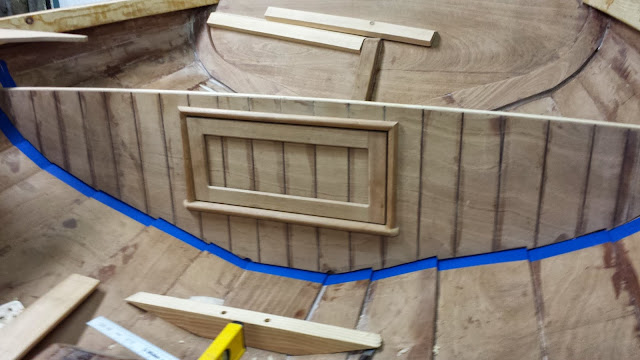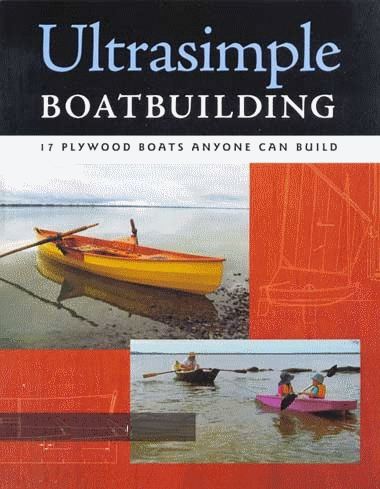 My next step was to build the aft bulkhead and install the aft deck beams.
My next step was to build the aft bulkhead and install the aft deck beams. The plans call for 3/8" ply (I'm using Robins Elite Sapele) which can be fitted either as one component or two halves. I elected to fit as a single component and so had to first scribe a vertical line on the inside of the hull where the bulkhead was to be positioned.
I spent considerable time with a laser beam with limited success so I ended up using straight edges clamped to a spirit level amidships, having first checked and rechecked that the hull was sitting level fore & aft and bow to stern.
Using a joggle stick which I clamped vertical on the hull, I drew point on the spiling board at each plank land which I then transferred onto the plywood to cut out the bulkhead shape. This proved quite successful although I needed two different joggle sticks to account for the longer lengths.
 Having cut out a template and satisfied myself to the final measurements, I transferred the measurements onto the final stock.
Having cut out a template and satisfied myself to the final measurements, I transferred the measurements onto the final stock. I then routed lines into the panel to imitate the paneling effect. I used a simple jig to space out the lines but on one run managed to misaligned the jig so I ended up having to fill the errant line with epoxy---shouldn't matter as this panel is to be painted.
I also brushed neat epoxy into the routed cuts to seal the ply. It fitted well into the hull requiring only small fillets of epoxy to make for a sturdy joint.
So far so good.
Next stage was to make the doors and fittings for the bulkhead which John Brooks advises to do before fitting the bulkhead. The plans call for the fitting to be looser than what you would allow for normal cabinet building...Hah - not ever having built a cabinet before, I reckoned that making them looser would most likely be the outcome!
 The profile of the trim called for quite a complex Z shape, which was to be repeated for the side lockers, so I elected to make all three at once.
The profile of the trim called for quite a complex Z shape, which was to be repeated for the side lockers, so I elected to make all three at once.Here you can see the Sapele being shaped mainly on the table saw and then router. I was quite pleased with the result. Next came to jointing the pieces which was quite time consuming but enjoyable work. The lower edge required a different profile with a small angled sill.
I decided to use TiteBond 3 to glue up the joints as they seemed to fit quite snugly and are not structural...plus I want to varnish these pieces so the TiteBond glue line should be less visible than epoxy.
Next step was to make the doors which also are encased in a Sapele frame, using half lap joints, This worked out quite nicely and I think it looks the part. When I first saw the Somes Sound in John's workshop, I was unsure if I could make such intricate (at least to my eyes) components, so I derived great satisfaction in getting them made.
Once I had all three frames and doors made, I installed the rear bulkhead. This time I used tape to form a neat fillet of epoxy. I'm not sure I would do this again, as the tape was quite difficult to remove later when the epoxy had set. Perhaps I should have pulled the tape once I was finished laying the epoxy and before it hardened.
 Once the aft bulkhead was installed, this gave me the reference height to fix the transom cleats for the aft deck. I was unsure as to how these cleats should be fitted, and a quick email to John Brooks elicited a very swift and concise response (Thanks John!) where he described how to make and use a declination level, whereby the level is fixed to a batton and raised at one end to allow for the correct fall from the aft end of the deck towards the bulkhead, so ensuring that water is not left lying on the deck. Also the deck has a camber to the sides to promote a dry deck and fair lines.
Once the aft bulkhead was installed, this gave me the reference height to fix the transom cleats for the aft deck. I was unsure as to how these cleats should be fitted, and a quick email to John Brooks elicited a very swift and concise response (Thanks John!) where he described how to make and use a declination level, whereby the level is fixed to a batton and raised at one end to allow for the correct fall from the aft end of the deck towards the bulkhead, so ensuring that water is not left lying on the deck. Also the deck has a camber to the sides to promote a dry deck and fair lines.The camber of the bulkhead is repeated in the deck beams and also the transom cleat. I made a template of the camber which ensured that all decking components were identical.
Additionally there are two curved cleats attached to the hull between the bulkhead and the transom.
Initially I misread the plans and so made them such that they lay to the same level as the top of the transom cleats on one end and to the top of the bulkhead at the other. Then on closer inspection of the plans and building instructions, I realized that these side cleats need to be lower down so that when the deck is attached, there is a gap between the deck and the hull so that water can drain down each side and to a limber hole aft of the bulkhead.
This is a very thoughtful detail, as it ensures that any water draining off the deck is carried away unsighted behind the bulkhead and into the bilge through two further limber holes at the bottom of the bulkhead, leaving the exposed surfaces of the deck and bulkhead unblemished by water marks. The more I get into building this boat, the more I am impressed with the attention to detail that John Brooks has engineered in his design.
Here you can see there the aft deck beams sit on top of the side cleats to ensure that the deck is fitted with a gap from the hull.
The plans call for quarter knees to be fitted to the hull and transom, but it is not clear to be how they should be designed - as the drawings do not look as if conventional knees are fitted on a horizontal plane between the transom and the side deck filler, rather sitting on a vertical pace between the transom cleat and the hull. I'll have to ruminate on these a bit more before deciding on how to proceed...unless any other SS builders out there can comment?
Next stage is to build the side lockers which provide support for the side seating. I have already made the doors and frames and a template for the sides of the locker, so it shouldn't be too long before that's accomplished. However we're heading off for a trip to Budapest to visit my daughter who is attending university there, so the building will have to wait until my return.
More later....Please feel free to comment with advise, critiques or suggestions.















0 comments:
Post a Comment